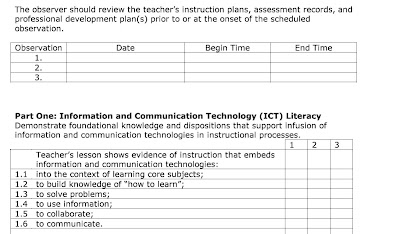1. Describe the purposes for and various stages of formative evaluation of technology plan.
Formative evaluation is also useful in analyzing learning
materials, student learning and achievements, and teacher effectiveness.
Formative evaluation is primarily a building process which accumulates a series
of components of new materials, skills, and problems into an ultimate
meaningful whole. - Wally Guyot (1978)A formative evaluation aims to improve
the instruction, whereas summative evaluation aims to prove the worth of the
instruction (Rieber, n.d.).
Since the technology plan is currently under development for
Hearne ISD which will include the elementary school’s technology goals, three
cycles of data collection will be used to analyze to make appropriate revisions
to the new plan with a projection date for the upcoming school year:
·
One-on-One Evaluation
·
Small group evaluation
·
Field test/trial
Questionnaires, surveys and interviews will be conducted to
ensure the data collected is accurate and valid. There should be at least three formative
evaluation stages used for Hearne ISD and the elementary school technology plan
that has a projection date of fall 2012 for the 2012-2013 school years. Since
the Technology Plan is not currently developed interviews and surveys have been
conducted to find the needs.
Technologist/computer lab teacher conducted by principal.
After hiring for the position of an Instructional Technologist, the principal will conduct evaluations of the instructional technologist by observing the IT assisting teachers with implementation of more technology within their lessons and or facilitation of training staff on the usage of new/old technology devices and or software.
Computer lab teacher- evaluations conducted by principal, mentor and master teachers according to the guidelines and rubrics of the TAP program that is in place for the entire district. The evaluators will be determining if the TEKS are being correctly taught in alignment with the current curriculum, CScope.
Small Group Evaluations conducted by a group to include Master teachers (subject-matter experts)
The Master Teachers will conduct small group evaluations on the Instructional Technologist and Computer lab teacher after the one-on-evaluations have been completed. This will be to determine if the findings from the pre-hire surveys were correct to determine the need for both positions. There will be interviews conducted for each grade level (1 teacher per subject area)
Target audience questions for the personal interviews:
* All surveys have to be completed after the new technology plan has been adopted and in place which will hire someone for both positions listed below.
Instructional Technologist
1. Have you had the opportunity to utilize the services of the Instructional Technologist? If yes please explain the assistance provided for you?
2. (if yes) Did the information or help you received from the technologist assist your needs in your classroom?
3. (if no to question 1) Are you planning any lessons in the future that will need the assistance of the Instructional Technologist?
4. Has the Instructional Technologist made themselves easily attainable to you and other staff members and if so by what means?
5. Do you feel more or less comfortable knowing that there is an Instructional Technologist available to assist teachers with their lessons?
Computer Lab Teacher
1. Have the student’s computer skills increased since the hiring of a new teacher for the computer lab.
2. Do the students discuss whether they are learning new skills in computer lab?
3. Have students learned their log in/password information?
4. Are the students using more computer terminology when using the computers in your classroom?
2. Describe your instruments used in a formative evaluation. (see question 1)
3. Collect data according to a formative evaluation plan for a given set of technology plan or instructor presentation.
Since Hearne ISD currently does not have a Technology or Professional Development Plan in place and one of the projected goals that have been written is to hire an Instructional Technologist, after the position is filled a professional survey should be conducted to determine if this position has a positive effect on each campus especially the elementary campus where the majority of the students are in attendance. This feedback will come from the teachers after the first semester to give adequate amount of time for the Instructional technologist to assist as many teachers as possible. This will allow more feedback from a variety of teachers on campus. The Master Teachers (3) should also be required to take the survey to determine if the new position has helped them in any issues they may have with lessons for TAP clusters.
Teacher Survey (professional instructors)
*Answers can only be provided after the position of Instructional Technologist has been created and filled.
1. Did the Instructional Technologist give detailed instructions during the Mini-Teach?
2. Did the Instructional Technologist provide handouts and or examples for the lesson being taught?
3. Did the Instructional Technologist suggest other teacher resources to use to assist your learning in the Mini-Teach to use in the classroom to implement more technology in your lessons?
4. Was the Mini-Teach requested by you or was it made mandatory for professional development for your grade level, subject area, or campus?
5. Did you find that this method of professional development was effective enough for immediate implementation in the classroom?
6. Is the Instructional Technologist effectively helping teachers meet the goals of the technology plan to create lifelong learners in a digital world?
After the surveys are compiled and evaluated, the results will determine if the position was actually an asset to the technology plan which will determine if the position will continue to be a part of the district or dissolved for the next school year or at the end of the currently adopted Technology Plan.
Resources
Guyot, W. (1978).
Rieber, L. (n.d.). Designing and Conducting Formative Evaluations. Retrieved October
29, 2011, from
http://www.lrieber.myweb.uga.edu/edit6170/ppt/formative_evaluation.ppt

